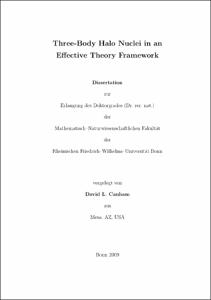Three-Body Halo Nuclei in an Effective Theory Framework

Three-Body Halo Nuclei in an Effective Theory Framework

| dc.contributor.advisor | Hammer, Hans-Werner | |
| dc.contributor.author | Canham, David L. | |
| dc.date.accessioned | 2020-04-14T00:40:03Z | |
| dc.date.available | 2020-04-14T00:40:03Z | |
| dc.date.issued | 02.07.2009 | |
| dc.identifier.uri | https://hdl.handle.net/20.500.11811/4087 | |
| dc.description.abstract | The universal properties and structure of halo nuclei composed of two neutrons (2n) and a core are investigated within an effective quantum mechanics framework. We construct an effective interaction potential that exploits the separation of scales in halo nuclei and treat the nucleus as an effective three-body system, which to leading order is described by the large S-wave scattering lengths in the underlying two-body subsystems. The uncertainty from higher orders in the expansion is quantified through theoretical error bands. First, we investigate the possibility to observe excited Efimov states in 2n halo nuclei. Based on the experimental data, 20C is the only halo nucleus candidate to possibly have an Efimov excited state, with an energy less than 7 keV below the scattering threshold. Second, we study the structure of 20C and other 2n halo nuclei. In particular, we calculate their matter density form factors, radii, and two-neutron opening angles. We then make a systematic improvement upon these calculations by extending the effective potential to the next-to-leading order. To this order, we require an additional two-body parameter, which we tune to the effective range of the interaction. In addition to range corrections to the 2n halo nuclei results, we show corrections to the Efimov effect in the three-boson system. Furthermore, we explore universality in the linear range corrections to the Efimov spectrum. Finally, we study the scattering of D0 and D*0 mesons and their antiparticles off the X(3872) in an effective field theory for short-range interactions. We present results for the S-wave scattering amplitude, total interaction cross section and S-wave scattering length. | |
| dc.language.iso | eng | |
| dc.rights | In Copyright | |
| dc.rights.uri | http://rightsstatements.org/vocab/InC/1.0/ | |
| dc.subject | Efimov-Effekt | |
| dc.subject | Mehr-Körper-Systeme | |
| dc.subject | Große Streulänge | |
| dc.subject | Kalte Atome | |
| dc.subject | Mesonische Moleküle | |
| dc.subject | Efimov Effect | |
| dc.subject | Few-Body Systems | |
| dc.subject | Cluster Models | |
| dc.subject | Large Scattering Length | |
| dc.subject | Mesonic Molecules | |
| dc.subject.ddc | 530 Physik | |
| dc.title | Three-Body Halo Nuclei in an Effective Theory Framework | |
| dc.type | Dissertation oder Habilitation | |
| dc.publisher.name | Universitäts- und Landesbibliothek Bonn | |
| dc.publisher.location | Bonn | |
| dc.rights.accessRights | openAccess | |
| dc.identifier.urn | https://nbn-resolving.org/urn:nbn:de:hbz:5N-17947 | |
| ulbbn.pubtype | Erstveröffentlichung | |
| ulbbnediss.affiliation.name | Rheinische Friedrich-Wilhelms-Universität Bonn | |
| ulbbnediss.affiliation.location | Bonn | |
| ulbbnediss.thesis.level | Dissertation | |
| ulbbnediss.dissID | 1794 | |
| ulbbnediss.date.accepted | 20.05.2009 | |
| ulbbnediss.fakultaet | Mathematisch-Naturwissenschaftliche Fakultät | |
| dc.contributor.coReferee | Meißner, Ulf-G. |
Dateien zu dieser Ressource
Das Dokument erscheint in:
-
E-Dissertationen (4077)




